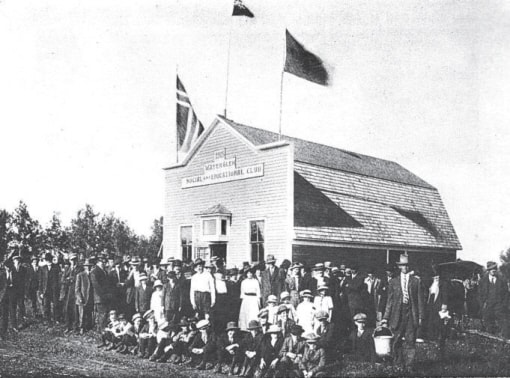Whether you are a history buff or not, most of us over the years have enjoyed wandering around old buildings and neighbourhoods, fondly recalling the great places where we used to hang out and marvelling at how our community landscape is constantly changing.
If you were trying to grow up in the 1950s and 60s like me, we will never forget such colorful community landmarks as: elevator row, the CPR train station, the hospital farm, the water tower, the black train trestle and others.
As kids, our favourite places to browse with the gang were likely: the old arena, the pool hall, the ice cream/candy shops, the movie theatres, the toy stores, our secret tree hut hangouts, and of course the schools, especially the classic Red Brick School and those cold old huts. It was always a great adventure to explore those special places, both in town and out in the county, but some were out of bounds if they had a fence, while others were said to be haunted, and we only entered if we were double-dared!
Those great old community halls
When we somehow managed to advance into teens and ventured out into the countryside in search of adventure and girls, you could spend many memorable hours at those grand old community halls, many of which are still standing to this day. For many glorious years these friendly havens among the trees served as schools and churches, as well as host to countless social activities such as weddings, funerals, family reunions, meetings, concerts, pie socials, bingos and elections.
From the Roaring Twenties and on, these rustic halls were also the heart of all the action for picnics, rodeos, ball tournaments, and whatever family event could be organized by hundreds of hard working and fun loving friends and neighbours. One will never forget those gala weekend dances at halls such as Morningside, Homeglen, the Elks, the Moose, Lincoln where over the years many a romance was sparked, countless friends were made, and there was even a few beers exchanged — as well as the odd spat.
Thank goodness in 2001 the Ponoka and District Retired Teachers’ Association undertook a wonderful project to honour those former traditional and colourful rural County of Ponoka schools that served hundreds of excited young rural students from 1905 to mid-century. Although many of them are gone, their original location and grounds are now marked with exquisite commemorative signs, where former students, teachers, families and guests are always welcome to visit and share all those cherished memories of the past.
Those great old outhouses of yesterday
Dare I say when we are chatting about grand old buildings of our past, we must not forget those diminutive and rustic old outhouses that were of course an important family facility in most urban and rural locations for several decades. Probably the most simple and true explanation of this stinky little structure out the back was it was a problem solver, an inspiration for invention, a place to get away from it all and calm our nerves or gather our thoughts, a dreamer’s paradise, and of course the not-so-comfortable place to serve the purpose for which it was intended. There would always be lots of reading materials and catalogues available in those outhouses, great for passing the time, but also a lifesaver if the toilet paper ran out.
In our first tiny Riverside home, the little outhouse was where we had to make a daring dash to reach, and whether it was in the middle of a frigid winter, in the heat of summer, during a storm or in the dark of night, there was absolutely no excuses or complaining. Some of those wooden biffies were equipped with two or more holes, likely designed for his and hers and the kids, then there was that big latch on the inside of the door for privacy, and many that had traditional half-moon carved in the door for decoration but mostly for ventilation.
What scared me the worst during those quick trips out there were the bees, bugs and flies as well as the coyotes howling at night. Needless to say, I didn’t hang around for long. This facility under the trees also had to be cleaned and if you couldn’t afford to hire Metro Hrycyk or Dunc Grant with their “honey wagons,” we usually had to do it ourselves with boiling hot water and disinfectant.
The early history of the outhouse actually goes back some 500 years to Europe, where fancy outside bathrooms were provided at hotels and other busy areas, featuring special sections for men and women, and many other amenities. In Montana there was once a posh social establishment that included a 12-hole outhouse; and then in a place called Gays, Ill. there was North America’s first and only two-storey outside toilet, with the second-floor staggered for disposal reasons. Thanks to fine citizens of Gays this facility has been preserved as a national historical site and has been forever named the infamous “skycrapper.”
Outhouses were of course a public necessity throughout the world for several centuries and remained until the invention of running water and the flush toilet forever pushed them to the brink of extinction. Some of the most popular names of outhouses in other countries included: the dunny or thunder box in Australia, and the ‘bog’ over in Britain. It is interesting to note the most expensive outhouse in the world was built by the United States National Park Service for $333,000, and the highest was situated halfway up on 14,494-foot Mount Whitney.
I am quite sure that some of these original most necessary outdoor monuments may still remain, just in case of an emergency or simply because they have been forgotten. The common outhouse has now been replaced by colorful porta-potties or ultramodern facilities at campgrounds or provincial parks, some that even require us to pay before we go.
